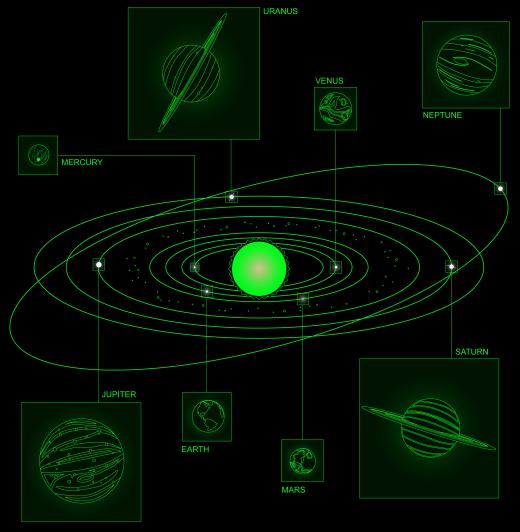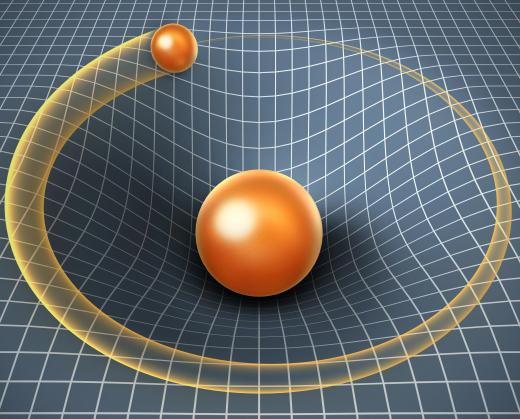Why do the Planets Orbit the Sun in an Elliptical Fashion?
The eight planets orbit the sun in an elliptical fashion primarily because of gravitational interactions. The sun has a gravitational pull, as do most planets; other celestial bodies do, too, and the ways in which these forces interact and either attract or repel each other causes orbiting. Most physicists and astronomers believe that the planetary orbits should be perfectly circular. That they are actually elliptical, many say, has more to do with outside forces and variance errors than anything else. German astronomer Johannes Kepler was the first to publish material proving elliptical orbits, and his theories are still considered definitive. They were added to and expanded on by Isaac Newton and Albert Einstein, among others.
Solar System Basics

The solar system is widely believed to contain eight planets, Earth included, that pass around a central sun at various intervals, each on their own elliptical track. Mercury, Venus, Earth, and Mars together make up what is known as the “inner” solar system. These planets rotate the most quickly. Much further out one finds the “outer” system, made up of Jupiter, Saturn, Uranus, and Neptune. These planets sit much farther from each other than do those in the inner rings, and their orbits tend to be much bigger, too. All of the orbits are elliptical in shape, though with the exception of Mercury they tend to appear almost perfectly circular. It is usually only through intense mathematical calculations that people discover they’re actually elliptical.
Influence of Eccentricity

Kepler was the first to identify the elliptical shape in the late 1600s. He came up with three related “laws of planetary motion” that quantify orbital movement with some precision. Through these laws he was able to explain that the planets move on a plane with the sun at one focus and determined that the shape of the ellipse should be measured in terms of eccentricity; namely, the more eccentric an orbit, the more elongated it is. Kepler did not determine why they orbit in an ellipse, but his groundwork was used by other physicists who came up with concrete explanations.
Importance of Gravity

Newton’s studies concluded that gravity plays a major role. Through a series of calculations he was able to show that planets pull on each other and the sun, as the sun also exerts a gravitational pull on them. This has the effect of squashing orbits that one might expect to be circular in a closed system, as the gravitational pulls act on each other. One way to think about this is to envision many hands pulling taffy.
Curvature of Space

The physical shape of the expanse of space also contributes. Einstein's theory of relativity also helps complete the explanation of why planets orbit the Sun in an elliptical fashion, since part of the shape of the orbits is a result of the curvature of space caused by planets acting on the space-time around them. The “bending” of space that results has a proportional impact on movement, and it forces what might otherwise be circular to flatten out and elongate.
Mathematical Applications
In most cases the only accurate way to measure orbits and calculate planetary velocity and movement is to undertake a number of somewhat complex mathematical computations. People can calculate the orbit of individual planets as well as entities like comets using the mathematical rules established by a Kepler, Newton, Einstein, and those that followed, and they can also use equations to track the degree of change over time. This information is useful for a number of applications, from programming telescopes for observation to determining the degree of threat posed by an approaching comet or asteroid.
Changes Over Time
It is important for people to remember that many descriptions of planetary orbits are simplistic for the sake of easy comprehension, and many place the sun as a fixed body in space that planets move around. In fact, the sun is in motion along with the planets, and as they move through space the precise shape of the orbits also changes. This should be kept in mind when looking at discussions of the way the planets orbit around the sun, as the entire orbital system is, in fact, actually moving.
AS FEATURED ON:
AS FEATURED ON:














Discussion Comments
'Most physicists and astronomers believe that the planetary orbits should be perfectly circular.'
No, there will be very few physicists or astronomers who believe they should be perfectly round. It takes very precise planning for instance to make a satellite travel in a near perfect circle.
If a satellite (e.g. the moon) is at given distance from the earth and is traveling perpendicular to the center of the earth at that time, it is either the furthest from the earth than it will be, or the closest to the earth that it will be. If it is the furthest, gravity will then begin to pull it in, as it's speed will have slowed due to gravitational forces. If it is as close as it will be to the earth, it will have sped up due to gravitational forces, and therefore move away from the earth.
This is not a good verbal explanation, a picture would be better. But the article is wrong.
See also the note:
'The sun has a gravitational pull, as do most planets'
All planets have gravitational pull.
I don't feel that this post answered the question it proposed.
If space is curved. How in the hell its not circular? I do not think other planets affect one another. Einstein was a speculator. He was wrong about space time. He is wrong about many things. E=mc2 is an idea he stole from another scientist when he worked in the patent office.
I thank whoever contributed the first paragraphs. So many resources dance around the question without producing a simple answer to a complex question. Kepler's mathematical formulas probably provide a clue but I don't want to get into this. The explanation that other gravitational sources contribute to the orbits being elliptical rather than a circular are satisfying for me. --CBBates
I suggest readers consult the many articles NASA scientists have published on the cause and nature of elliptical orbits. These are articles by genuine scientists, not amateur speculators like Miles Mathis. Mathis is not a scientist and has never done the work necessary to become one. Aside from writing crackpot opinions on his website he has no credentials whatsoever and lives isolated in a hovel in Taos, NM.
Mathis believes 9/11 and the moon landings were hoaxes and that the value of pi is not 3.14 but 4.0. Please do not be deceived by an internet kook. Learn your science from a scientist.
According to Miles Mathis in "explaining the Ellipse," Newton posited an innate motion which is the same throughout, but showed there.
Gravitational acceleration is stronger at perihelion than aphelion. This requires that the curved arc at perihelion must be smaller/ tighter than at aphelion. Both express vectors. This means that, in order to have an ellipse, another force is required.
I suggest readers research Miles Mathis explaining the ellipse, and learn for themselves that there is a serious problem between Newton's law and the shape of elliptical orbits. They can then post their mathematical criticisms for Mathis to address. To date, no one has shown he is in error mathematically.
@anon63169: While there is no physical object there, the common center of gravity of the object and the Sun lay at that point. For an example, the common center of gravity for Earth - Moon is actually inside the Earth, but we still orbit it.
I suspect that elliptical orbits originated from the spiral nature of the early solar system.
As the planets formed from the condensate, they had a slight angular momentum like incoming projectiles that were captured in the warped space-time (a.k.a. "gravity") of the sun and this created the non-circular configurations.
I see now that the gravitational pull of the sun has something to do with it.
You are explaining why planets orbit the sun in an elliptical path and the answer is planets orbit the sun in an elliptical path by kepler's law.
why an ellipse if there is "nothing at the other focus point"?
I love this article. its so amazing that i've been very inspired and i want this astronomy to be my goal and inspiration for the rest of my living. Keep up the good searching and keep on inspiring people like me!
Post your comments